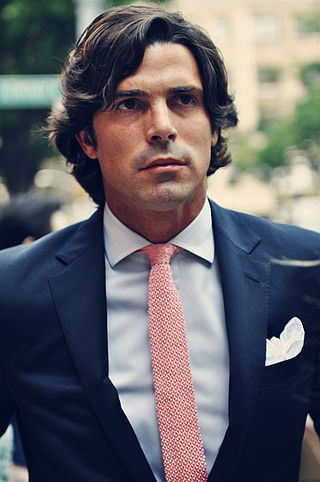Related Research Articles
Horatio A. Luro was a thoroughbred horse racing trainer in the United States.
Greentree Stable, in Red Bank, New Jersey, was a major American thoroughbred horse racing stable and breeding farm established in 1914 by Payne Whitney of the Whitney family of New York City. Payne Whitney operated a horse farm and stable at Saratoga Springs, New York with his brother Harry Payne Whitney, who also had a large stable of horses. Greentree Stable had a training base at Aiken, South Carolina, while Greentree Farm in Lexington, Kentucky was established in 1925 as its breeding arm.
PM was a liberal-leaning daily newspaper published in New York City by Ralph Ingersoll from June 1940 to June 1948 and financed by Chicago millionaire Marshall Field III.

Samuel Clay Hildreth was an American Thoroughbred horse racing Hall of Fame trainer and owner.

Lucius Morris Beebe was an American writer, gourmand, photographer, railroad historian, journalist, and syndicated columnist.
Corey Ford was an American humorist, writer, outdoorsman, and screenwriter. He was friendly with several members of the Algonquin Round Table in New York City and occasionally lunched there.
Hirsch Jacobs was an American thoroughbred horse trainer and owner.
Andrew Beyer is an American expert on horse race betting who designed the Beyer Speed Figure.
Rogers Ernest Malcolm Whitaker was an editor of The New Yorker magazine who was known to readers for his many contributions to Talk of the Town under the pen name of E. M. Frimbo, World's Greatest Railroad Buff.
The Real Paper was a Boston-area alternative weekly newspaper with a circulation in the tens of thousands. It ran from August 2, 1972, to June 18, 1981, often devoting space to counterculture and alternative politics of the early 1970s. The offices were in Cambridge, Massachusetts.
François Boutin was a French Thoroughbred horse trainer.
Joe Hirsch was an American horse racing columnist and the founding president of the National Turf Writers Association.

Max Vadukul, is a British-Indian photographer based in Milan, Italy. Noted for his black-and-white imagery, Vadukul expressed his preference for monochrome photography as superior, stating, “Black-and-white is king. King of kings. Color is Commercial”, in an interview with J’aipur journal. He holds the distinction of being the first photographer of Indian origin to publish in the editions of Paris, Italian, British, and American Vogue, photographing celebrated figures such as Amy Winehouse, Tilda Swinton, Beyonce, Paul McCartney, Natalie Portman, Tom Hanks, Justine Timberlake, and many more. Sting has described his photography as a sort of "On the move style". The National Geographic channel produced a feature documentary on Vadukul in 2000 about the improbable arc of his life after Africa; the documentary continues to air around South Asia today.

Joseph Nocera is an American business journalist and author. He has written for The New York Times since April 2005, writing for the editorial page from 2011 to 2015. He was also an opinion columnist for Bloomberg Opinion. He has co-written the books The Big Fail, A Piece of the Action and All the Devils Are Here.

Raymond Richard Guest OBE was an American businessman, thoroughbred race horse owner and polo player. From 1965 to 1968, he was United States Ambassador to Ireland.
The Flash Stakes was a race for two-year-old Thoroughbred horses and one of the longest running horse racing events in America. Run before races were graded, the Flash was won by a host of starry names. Begun before the United States Hotel Stakes, it was the oldest race for juveniles of either gender in the United States.
Emory Lavelle "Buddy" Ensor was an American Thoroughbred horse racing Hall of Fame jockey.

Ignacio "Nacho" Figueras Bermejo is an Argentine polo player and model with a 6-goal handicap. Dubbed the "David Beckham of polo", Figueras is considered to be the most famous polo player in the world. He currently co-owns and plays for Black Watch Polo Team. Since 2005, Figueras has been the face of Ralph Lauren's Black Label. In 2015, models.com ranked him in the top eighteen of their Money Men.
Big Blue Kitten is an American Thoroughbred racehorse who specialises in turf races. Unraced as a juvenile, he finished third on his debut in 2011 and then went on a five race winning streak, culminating in a victory in the Grade II National Museum of Racing Hall of Fame Stakes. After winning one minor race as a four-year-old he emerged as a top-class turf performer in 2013 when his wins included the United Nations Stakes and the Sword Dancer Invitational Stakes. His only win of consequence in 2014 came in the Lure Stakes but he returned to his best as a seven-year-old in 2015 winning the Fort Marcy Handicap, a second United Nations Stakes and the Joe Hirsch Turf Classic Invitational Stakes. Apart from his victories he finished second in the Arlington Million and third in the Breeders' Cup Turf. His performances earned him the title of American Champion Male Turf Horse for 2015.

Harry Austen La Montagne was a French-American horse owner, artist, sculptor, war veteran and sportsman.
References
- 1 2 3 4 5 6 7 8 9 10 Reg Lansberry, "The New Yorker's Audax Minor: A Legend Recalled," Mid-Atlantic Thoroughbred, November 2006.
- ↑ Audax Minor, The Race Track, "Back to the Mines," The New Yorker, September 10, 1960, p. 129.
- 1 2 Milestones, Times Oct. 22, 1979
- ↑ "Hollingsworth, Beyer, Ryall Selected to Joe Hirsch Media Honor Roll". Paulick Report. 2013-12-03. Retrieved 2019-02-06.